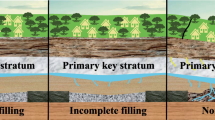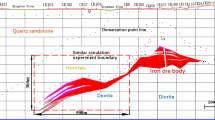Abstract
The stability of underground mines represents a key issue for active and abandoned mines. Over the last few years, several collapses of underground mines in France have affected existing buildings and infrastructures. Many factors are generally identified as the cause of failures: pillar ageing, fractures, and pillars’ height to width ratio, etc. Among the treatment techniques available to prevent instability and reduce the deterioration of pillars, backfill is the most frequently used. A research programme, supported by the French Ministry of the Environment, was developed to study the operability of partial and total backfill using waste material in the Livry-Gargan gypsum mine (near Paris, France), where pillar height is 17 m. The paper focuses on: (1) the characterisation of the gypsum and fill material (laboratory and in situ tests), (2) the in situ measurements, involving 5 pillars equipped with 19 pressure cells, since 1999, (3) and numerical modelling of fractured pillars performed in order to improve understanding of the effects of backfill on the stability of room-and-pillar mines. The study clearly shows the operability and the advantages of partial and total backfill for short-term pillar stability. The induced horizontal pressure generated by backfill can reach 200 kPa. The use of numerical modelling also shows the effect of backfill on fractures and that backfill reduces indicatively the shear displacement and the opening of fractures. Numerical modelling helps in identifying the mechanisms of backfill and in a better understanding of the behaviour of backfilled mines.






















Similar content being viewed by others
Abbreviations
- E f :
-
Fill Young modulus
- E g :
-
Young modulus of gypsum (pillar young modulus)
- K n :
-
Normal stiffness of joint
- K s :
-
Shear stiffness of joint
- U s :
-
Shear displacement of the interface between backfill and pillar
- W :
-
Pillar width
- H :
-
Pillar height
- α, β:
-
Constants for pillar strength calculation
- F :
-
Safety factor
- R c :
-
Compression strength
- R t :
-
Tensile strength
- R p :
-
Pillar strength
- R ce :
-
Equivalent radius of the chamber
- R 0 :
-
Equivalent radius of the gypsum pillar
- S max :
-
Maximum subsidence
- O :
-
Height of excavated room
- t :
-
Time (days)
- γp :
-
Deviatoric plastic strain
- εp :
-
Total plastic strain
- c :
-
Cohesion of the rock matrix
- φ:
-
Friction angle of the rock matrix and joint
- ψ:
-
Dilatency angle of the rock matrix and joint
- ν:
-
Poisson ratio
- ρ:
-
Mass density
- ε:
-
Strain
- σv :
-
Initial vertical stress
- σh1 :
-
First initial horizontal stress
- σh2 :
-
Second initial horizontal stress
- σp :
-
Pillar stress
- σ ah :
-
Active stress
- σ ph :
-
Passive stress
- σs :
-
Interface shear stress
- τ:
-
Extraction ratio
- Δσ xx :
-
Induced horizontal stress
- Δσ yy :
-
Induced vertical stress
References
Aubertin M, Li L, Arnoldi S, Belem T, Bussière B, Benzaazoua M, Simon R (2003) Interaction between backfill and rock mass in narrow stopes. 12th Panamerican conference on soil mechanics and geotechnical engineering and 39th US rock mechanics symposium
Auvary Ch, Homand F, Hoxa D (2008) The influence of relative humidity on the rate of convergence in an underground mine. Int J Rock Mech Mining Sci 45:1454–1468
Auvray Ch (2003) Vieillissement et comportement rhéologique de gypse. Thèse INPL—Ecole de Géologie de Nancy, 278 p
Auvary Ch, Homand F, Sorgi C (2004) The ageing of gypsum in underground mines. Eng Geol 74(3–4):183–196
Bell FG, Stacey TR, Genske DD (2000) Mining subsidence and its effect on the environment: some differing examples. Environ Geol 40(1–2):135–152
Castellanza R, Nova R (2004) Oedometric tests on artificially weathered carbonatic soft rocks. J Geotech Geoenviron Eng 130(7):728–738
Collet T, Masrouri F, Didier C (2003) Partial backfilling effect in underground mines. In: Natau O, Fecker E. Pimentel E (eds) Geotechnical measurements and modeling. Swets and Zeitlinger, Lisse. ISBN:9058096033
Cundall PA, Hart RD (1992) Numerical modeling of discontinua. Eng Comp 9(2):101–113
Das MN (1986) Influence of width/height ratio on the post-failure behavior of coal. Int J Min Geol Eng (4):79–87
Didier C, Salmon R (2004) Evaluation du risque d’apparition d’un fontis en surface : un modèle volumétrique probabiliste. JNGG 2004, Lille, pp 451–462
Elshayeb Y, Kounaili S, Josien JP, Gueniffy Y (2001) Towards the determination of surface collapse type over abandoned mine in the Lorraine iron basin. In: Särkkä P, Eloranta P (eds) Rock mechanics—a challenge for society, Swets and Zeitlinger, Lisse, pp 819–824
Fine J (1979) Caractérisation de gypse de la carrière de Livry-Gargan. Ecole des Mines de Paris SE 79/3
Gerolymatou E, Nova R (2006) An analysis of chamber filling effect on the remediation of flooded gypsum and anhydrite mines. Rock Mech Rock Eng 41(3):403–419
Idris J, Verdel T, Al Heib M (2007) Numerical modelling and mechanical behaviour analysis of ancient tunnel masonry structures. Tunnelling and Underground Space Technology. TUST-D-06-00083R1
Josien JP (2006) Quantification du risque en géotechnique, démarche développée dans les plans de prévention des risques miniers. Journées Nationales de Géotechnique et de Géologie de l’Ingénieur, Lyon
Kesimal A, Yimaz E, Erckikdi B (2004) Evaluation of paste backfill mixture consisting of sulphide-rich mill tailing and varying cement contents. Cement and Concrete Research 34
Mark Ch (2006) The evolution of intelligent coal pillar design: 1981–2006. 25th international conference on ground control in mining, pp 325–333
Martin CD, Maybee WG (2000) The strength of hard-rock pillars. Int J of Rock Mech Min Sci 37(2000):1239–1246
Mishra MK, Rao Karanam UM (2006) Geotechnical characterization of fly composites for backfilling mine voids. Geotech Geol Eng 24:1749–1765
Piguet JP, Wojtkowiak F (2001) Affaissements et déformations au-dessus des exploitations minières: mécaniques et évolution dans le temps. Mines et Carrières -Industrie Minérale, Juin 2001
Salamon MDG (1992) Strength and stability of coal pillars. Proceedings of the workshop on coal pillars mechanics and design. BuMines, IC 9315:95–121
Sivakugan N, Rankine RM, Rankine KJ, Rankine KS (2006) Geotechnical consideration in mine backfilling in Australia. J Clean Prod 14(2006):1168–1175
Swift GM, Reddish D (2002) Stability problems associated with an abandoned ironstone mine. Bull Eng Geol Env 61:227–239
Tesarik DR, Seymour JB, Yanske TR (2003) Post-failure behavior of two mines pillars confined with backfill. Int J Rock Mech Mining Sci 40:221–232
Vachat JC (1982) Les désordres survenant dans les carrières de la région parisienne. Etude théorique et pratique de l’évolution des fontis. Mémoire présenté au conservatoire national des arts et métiers, chair de géologie appliquée aux bâtiments et aux travaux publics
Wang JA, Shang XC, Ma HT (2008) Investigation of catastrophic ground collapse in Xingtai gypsum mines in China. Int J Rock Mech Min Sci 45:1480–1499
Author information
Authors and Affiliations
Corresponding author
Additional information
An erratum to this article can be found at http://dx.doi.org/10.1007/s00603-009-0072-y
Rights and permissions
About this article
Cite this article
Al Heib, M.M., Didier, C. & Masrouri, F. Improving Short- and Long-term Stability of Underground Gypsum Mine Using Partial and Total Backfill. Rock Mech Rock Eng 43, 447–461 (2010). https://doi.org/10.1007/s00603-009-0066-9
Received:
Accepted:
Published:
Issue Date:
DOI: https://doi.org/10.1007/s00603-009-0066-9




